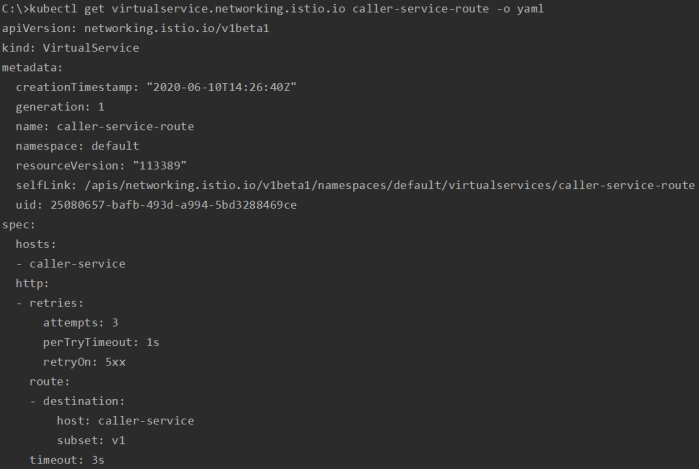

Spring Boot Library for integration with Istio
source link: https://piotrminkowski.wordpress.com/2020/06/10/spring-boot-library-for-integration-with-istio/
Go to the source link to view the article. You can view the picture content, updated content and better typesetting reading experience. If the link is broken, please click the button below to view the snapshot at that time.

Spring Boot Library for integration with Istio
In this article I’m going to present an annotation-based Spring Boot library for integration with Istio. The Spring Boot Istio library provides auto-configuration, so you don’t have to do anything more than including it to your dependencies to be able to use it.
The library is using Istio Java Client me.snowdrop:istio-client for communication with Istio API on Kubernetes. The following picture illustrates an architecture of presented solution on Kubernetes. The Spring Boot Istio is working just during application startup. It is able to modify existing Istio resources or creating new if there are no matching rules found.

Source code
The source code of library is available on my GitHub repository https://github.com/piomin/spring-boot-istio.git.
How to use it
To use in your Spring Boot application you include the following dependency.
<dependency><groupId>com.github.piomin</groupId><artifactId>spring-boot-istio</artifactId><version>0.1.0.RELEASE</version></dependency>After that you should annotate one of your class with @EnableIstio. The annotation contains several fields used for Istio DestinationRule and VirtualService objects.
@RestController@RequestMapping("/caller")@EnableIstio(version = "v1", timeout = 3, numberOfRetries = 3)public class CallerController {private static final Logger LOGGER = LoggerFactory.getLogger(CallerController.class);@AutowiredBuildProperties buildProperties;@AutowiredRestTemplate restTemplate;@Value("${VERSION}")private String version;@GetMapping("/ping")public String ping() {LOGGER.info("Ping: name={}, version={}", buildProperties.getName(), version);String response = restTemplate.getForObject("http://callme-service:8080/callme/ping", String.class);LOGGER.info("Calling: response={}", response);return "I'm caller-service " + version + ". Calling... " + response;}}The name of Istio objects is generated basing on spring.application.name. So you need to provide that name in your application.yml.
spring:application:name: caller-serviceCurrently there are five available fields that may be used for @EnableIstio.
@Target({ElementType.TYPE})@Retention(RetentionPolicy.RUNTIME)@Documentedpublic @interface EnableIstio {int timeout() default 0;String version() default "";int weight() default 0;int numberOfRetries() default 0;int circuitBreakerErrors() default 0;}Here’s the detailed description of available parameters.
version– it indicates the version of IstioSubset. We may define multiple versions of the same application. The name of label isversionweight– it sets a weight assigned to theSubsetindicated by theversionlabeltimeout– a total read timeout in seconds on the client side – including retriesnumberOfRetries– it enables retry mechanism. By default we are retrying all 5XX HTTP codes. The timeout of a single retry is calculated astimeout / numberOfRetriescircuitBreakerErrors– it enables circuit breaker mechanism. It is based of a number of consecutive HTTP 5XX errors. If circuit is open for a single application it is ejected from the pool for 30 seconds
How it works
Here’s the Deployment definition of our sample service. It should be labelled with the same version as set inside @EnableIstio.
apiVersion: apps/v1kind: Deploymentmetadata:name: caller-servicespec:replicas: 1selector:matchLabels:app: caller-servicetemplate:metadata:name: caller-servicelabels:app: caller-serviceversion: v1spec:containers:- name: caller-serviceimage: piomin/caller-serviceimagePullPolicy: IfNotPresentports:- containerPort: 8080Let’s deploy our sample application on Kubernetes. After deploy we may verify the status of Deployment.

The name of created DestinationRule is a concatenation of spring.application.name property value and word -destination.

The name of created VirtualService is a concatenation of spring.application.name property value and word -route. Here’s the definition of VirtualService created for annotation @EnableIstio(version = "v1", timeout = 3, numberOfRetries = 3) and caller-service application.

How it is implemented
We need to define bean that implements BeanPostProcessor interface. On application startup it is trying to find the annotation @EnableIstio. If such annotation exists it takes a value of its fields and then it is creating new Istio objects or editing the currently existing objects.
public class EnableIstioAnnotationProcessor implements BeanPostProcessor {private final Logger LOGGER = LoggerFactory.getLogger(EnableIstioAnnotationProcessor.class);private ConfigurableListableBeanFactory configurableBeanFactory;private IstioClient istioClient;private IstioService istioService;public EnableIstioAnnotationProcessor(ConfigurableListableBeanFactory configurableBeanFactory, IstioClient istioClient, IstioService istioService) {this.configurableBeanFactory = configurableBeanFactory;this.istioClient = istioClient;this.istioService = istioService;}public Object postProcessBeforeInitialization(Object bean, String beanName) throws BeansException {EnableIstio enableIstioAnnotation = bean.getClass().getAnnotation(EnableIstio.class);if (enableIstioAnnotation != null) {LOGGER.info("Istio feature enabled: {}", enableIstioAnnotation);Resource<DestinationRule, DoneableDestinationRule> resource = istioClient.v1beta1DestinationRule().withName(istioService.getDestinationRuleName());if (resource.get() == null) {createNewDestinationRule(enableIstioAnnotation);} else {editDestinationRule(enableIstioAnnotation, resource);}Resource<VirtualService, DoneableVirtualService> resource2 = istioClient.v1beta1VirtualService().withName(istioService.getVirtualServiceName());if (resource2.get() == null) {createNewVirtualService(enableIstioAnnotation);} else {editVirtualService(enableIstioAnnotation, resource2);}}return bean;}}We are using API provided by Istio Client library. It provides a set of builders dedicated for creating elements of Istio objects.
private void createNewDestinationRule(EnableIstio enableIstioAnnotation) {DestinationRule dr = new DestinationRuleBuilder().withMetadata(istioService.buildDestinationRuleMetadata()).withNewSpec().withNewHost(istioService.getApplicationName()).withSubsets(istioService.buildSubset(enableIstioAnnotation)).withTrafficPolicy(istioService.buildCircuitBreaker(enableIstioAnnotation)).endSpec().build();istioClient.v1beta1DestinationRule().create(dr);LOGGER.info("New DestinationRule created: {}", dr);}private void editDestinationRule(EnableIstio enableIstioAnnotation, Resource<DestinationRule, DoneableDestinationRule> resource) {LOGGER.info("Found DestinationRule: {}", resource.get());if (!enableIstioAnnotation.version().isEmpty()) {Optional<Subset> subset = resource.get().getSpec().getSubsets().stream().filter(s -> s.getName().equals(enableIstioAnnotation.version())).findAny();resource.edit().editSpec().addAllToSubsets(subset.isEmpty() ? List.of(istioService.buildSubset(enableIstioAnnotation)) :Collections.emptyList()).editOrNewTrafficPolicyLike(istioService.buildCircuitBreaker(enableIstioAnnotation)).endTrafficPolicy().endSpec().done();}}private void createNewVirtualService(EnableIstio enableIstioAnnotation) {VirtualService vs = new VirtualServiceBuilder().withNewMetadata().withName(istioService.getVirtualServiceName()).endMetadata().withNewSpec().addToHosts(istioService.getApplicationName()).addNewHttp().withTimeout(enableIstioAnnotation.timeout() == 0 ? null : new Duration(0, (long) enableIstioAnnotation.timeout())).withRetries(istioService.buildRetry(enableIstioAnnotation)).addNewRoute().withNewDestinationLike(istioService.buildDestination(enableIstioAnnotation)).endDestination().endRoute().endHttp().endSpec().build();istioClient.v1beta1VirtualService().create(vs);LOGGER.info("New VirtualService created: {}", vs);}private void editVirtualService(EnableIstio enableIstioAnnotation, Resource<VirtualService, DoneableVirtualService> resource) {LOGGER.info("Found VirtualService: {}", resource.get());if (!enableIstioAnnotation.version().isEmpty()) {istioClient.v1beta1VirtualService().withName(istioService.getVirtualServiceName()).edit().editSpec().editFirstHttp().withTimeout(enableIstioAnnotation.timeout() == 0 ? null : new Duration(0, (long) enableIstioAnnotation.timeout())).withRetries(istioService.buildRetry(enableIstioAnnotation)).editFirstRoute().withWeight(enableIstioAnnotation.weight() == 0 ? null: enableIstioAnnotation.weight()).editOrNewDestinationLike(istioService.buildDestination(enableIstioAnnotation)).endDestination().endRoute().endHttp().endSpec().done();}}Recommend
About Joyk
Aggregate valuable and interesting links.
Joyk means Joy of geeK